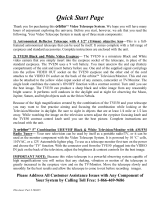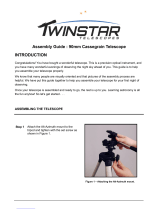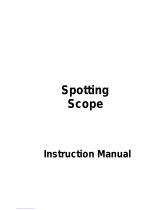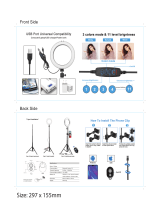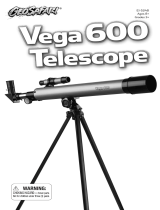
INDEX
CONTENTS
Introduction
The most sophisticated and easiest
to use telescope ever . . . . . . . . . . . . . . . . . . . . . . . .3
Getting Started
Assembling the Telescope and using LightSwitch
Assembling the tripod . . . . . . . . . . . . . . . . . . . . . . . .5
Mounting the tripod . . . . . . . . . . . . . . . . . . . . . . . . . .6
Installing the batteries. . . . . . . . . . . . . . . . . . . . . . . .6
Using an AC Adapter or DC Power Cord . . . . . . . . .6
Attaching Accessories. . . . . . . . . . . . . . . . . . . . . . . .7
Telescope is now Fully Assembled . . . . . . . . . . . . . .7
Powering up the Telescope - LightSwitch
Technology™ . . . . . . . . . . . . . . . . . . . . . . . . . . . . . .8
AutoStar III Handbox – Basic Usage
Basics . . . . . . . . . . . . . . . . . . . . . . . . . . . . . . . . . . . .9
Navigating the Menus . . . . . . . . . . . . . . . . . . . . . . . .9
Changing Modes. . . . . . . . . . . . . . . . . . . . . . . . . . .10
Menu Mode. . . . . . . . . . . . . . . . . . . . . . . . . . . . . . .10
Scope Info Mode. . . . . . . . . . . . . . . . . . . . . . . . . . .10
Sky Map Mode . . . . . . . . . . . . . . . . . . . . . . . . . . . .10
Shortcuts. . . . . . . . . . . . . . . . . . . . . . . . . . . . . . . . .10
LS Key Features
Telescope
Key Features identifi ed on the Telescope. . . . . . . .11
Key Features Explained . . . . . . . . . . . . . . . . . . . . .13
Using the Red-Dot Finder . . . . . . . . . . . . . . . . . . . .15
Adjusting the Red-Dot Finder . . . . . . . . . . . . . . . . .15
Optional MEADE
®
Accessories
Choosing Eyepieces . . . . . . . . . . . . . . . . . . . . . . . .16
Meade Series 4000 Super Plössl Eyepieces . . . . .16
Meade Series 5000 Premium Eyepieces . . . . . . . .17
Power Supplies. . . . . . . . . . . . . . . . . . . . . . . . . . . .18
Imagers and related Accessories . . . . . . . . . . . . . .18
AutoStar III Handbox
Buttons, Display and their functions . . . . . . . . . . . .19
Menu Tree. . . . . . . . . . . . . . . . . . . . . . . . . . . . . . . .23
Guided Tour Menu. . . . . . . . . . . . . . . . . . . . . . . . . .24
Object Menu . . . . . . . . . . . . . . . . . . . . . . . . . . . . . .24
Event Menu. . . . . . . . . . . . . . . . . . . . . . . . . . . . . . .25
Take Picture Menu . . . . . . . . . . . . . . . . . . . . . . . . .25
Utilities Menu. . . . . . . . . . . . . . . . . . . . . . . . . . . . . .26
Setup Menu. . . . . . . . . . . . . . . . . . . . . . . . . . . . . . .27
Advanced LS Features
Two Star Alt Az Alignment. . . . . . . . . . . . . . . . . . . .29
One Star Alt Az Alignment. . . . . . . . . . . . . . . . . . . .30
Finding objects not in the database . . . . . . . . . . . .30
Landmarks . . . . . . . . . . . . . . . . . . . . . . . . . . . . . . .30
Observing Satellites . . . . . . . . . . . . . . . . . . . . . . . .31
Terrestrial Observing. . . . . . . . . . . . . . . . . . . . . . . .32
Maintenance
Basic Maintenance . . . . . . . . . . . . . . . . . . . . . . . . .33
Collimation . . . . . . . . . . . . . . . . . . . . . . . . . . . . . . .33
Inspecting the Optics. . . . . . . . . . . . . . . . . . . . . . . .35
Gauging the Movement of the Telescope . . . . . . . .35
Updating Your LS Firmware . . . . . . . . . . . . . . . . . .35
SD Card for Updates and Image Storage. . . . . . . .36
Meade Customer Service
How to get in contact. . . . . . . . . . . . . . . . . . . . . . . .36
Appendix A:
Training the Drive . . . . . . . . . . . . . . . . . . . . . . . . . .37
Appendix B:
Creating User Objects. . . . . . . . . . . . . . . . . . . . . . .38
Appendix C:
Basic Astronomy . . . . . . . . . . . . . . . . . . . . . . . . . . .39
Specifi cations
LS-6 ACF: . . . . . . . . . . . . . . . . . . . . . . . . . . . . . . . .41
LS-6 SC: . . . . . . . . . . . . . . . . . . . . . . . . . . . . . . . . .42
LS-8 ACF. . . . . . . . . . . . . . . . . . . . . . . . . . . . . . . . .43
LS-8 SC. . . . . . . . . . . . . . . . . . . . . . . . . . . . . . . . . .44
Declarations
FCC: . . . . . . . . . . . . . . . . . . . . . . . . . . . . . . . . . . . .45
WEEE:. . . . . . . . . . . . . . . . . . . . . . . . . . . . . . . . . . .46
Meade Warranty
One Year Limited Warranty. . . . . . . . . . . Back Cover
® The name “Meade,” “AutoStar”, “LightSwitch” and the Meade
logo are trademarks registered with the U.S. Patent and Trademark
Offi ce and in principal countries throughout the world.
“SmartFinder”, “Deep Sky Imager”, “LS”, and “Tonight’s Best” are
trademarks of Meade Instruments Corporation.
Patents:
US 7,277,223, US 7,079,317, US 7,092,156
US 6,304,376, US 7,221,527, US 6,922,283
US 6,392,799
© 2009 Meade Instruments Corporation.
BATTERY SAFETY INSTRUCTIONS:
• Always purchase the correct size and grade of battery:
8 x “C-type” Alkaline batteries (ANSI 14A, 14AC/
IEC LR14).
• Always replace the whole set of batteries at one time,
taking care not to mix old and new ones, or batteries of
different types.
• Clean the battery contacts and also those of the device
prior to battery installation.
• Ensure the batteries are installed correctly with regard to
polarity (+ and -).
• Remove batteries from equipment which is not to be
used for an extended period of time.
• Remove used batteries promptly.
• Never attempt to recharge primary batteries as this may
cause leakage, fi re, or explosion.
• Never short-circuit batteries as this may lead to high
temperatures, leakage, or explosion.
• Never heat batteries in order to revive them.
• Remember to switch off devices after use.
• Keep batteries out of the reach of children; small
batteries may be ingested.
• Seek medical advice immediately if a battery has
been swallowed.
Caution: If batteries or parts are swallowed, see a
doctor immediately.





















